
Agnieszka Kurant, Air Rights 2 (2015)
Photo: Vegard Kleven
“Momentum,” the 8th Nordic Biennial of Contemporary Art, opened in the city of Moss in Norway this weekend.
The young biennial, curated by Stefanie Hessler, Toke Lykkeberg, Jonatan Habib Engqvist, and Birta Gudjonsdottir, features its own soundtrack, its own scent, and its own (temporary) tattoo.
It’s theme, the concept of “tunnel vision,” explores the ways in which we look at ourselves and at the world through the internet and conspiracy theories, along with the creeping ways in which different elements of society and technology infiltrate our lives. Many of the works featured in the exhibition, thus, employ new media and cutting edge technologies.
Upon entering the large industrial Punkt Ø kunsthalle that houses one half of the biennial, a fog installation by Japanese artist Fujiko Nakaya, entitled Glacial Fog Falls. Fog Installation #01494, Momentum Biennial 2015, Moss (2015), welcomes the visitor.
Interwoven with this work is the interactive piece by Swedish duo Lundhal & Seitl, titled Symphony (2105). Famous for their use of sensory deprivation within their oeuvre, this piece involves dancers-as-tour-guides, sound, and goggles. The strangest thing about this work is how easily you trust the hand that leads. Lundhal & Seitl, also a couple in real life, are concerned with the gaps the brain fills in when senses are deprived, again feeding into the theme of our relationship with technology.
Hrafnhildur Arnardottir a.k.a Shoplifter, Nervescape IV(2015
Photo: Vegard Kleven
Next, visitors are greeted by a garish installation by Hrafnhildur Arnardottir a.k.a Shoplifter, entitled Nervescape IV (2015), a huge, bright, and furry abstract painting that can be climbed and sat on. The piece is a collaboration with Swedish pop star and performance artist Zhala, who performed at the opening and whose sound piece BaBYy Wwheeree isS ThE KI (2015) plays from various parts of the installation.
Walking through Shoplifter’s installation, one reaches a cave filled with screens tracking individuals around Minsk, Moscow, and Moss. Visitors who download the Paranoia App (2015) by Valia Fetisov, Dzina Zhuk, and Nicolay Spesivtsev can follow fellow users or be followed by them. The work plays on the paranoia we all feel as we willingly upload all of our data onto the internet for all to see.
In a world where we are always engaged with technology, we are also increasingly obsessed with cleansing our minds and bodies. In Edward Shenk’s video Part III – Battlefield Wikipedia (2015), we follow the path of a man’s dark journey in seeking to decalcify his pineal gland. Meanwhile, the scent-based work MOVX_015 (2015), by smell researcher and artist Sissel Tolas, permeates the entire building.
Christine Ödlund, Tower of Eukaryote (2015)
Photo: Vegard Kleven
The top floor of the kunsthalle is split into light and dark, both aesthetically and thematically. A towering garden by Christine Ödlund, entitled Tower of Eukaryote (2015), is filled with stinging nettles, which have butterfly larvae eating them. The work plays on the fact that the nettles, when being eaten, emit an inaudible scream. Over the course of the exhibition, the larvae will hatch into butterflies.
The increasing obsession with urban space is addressed in Agnieszka Kurant’s Air Rights 2 (2015), in which a space rock hovers in mid-air above a plinth. The work is inspired by the sale of space above buildings in New York, which ensures the buyer never loses the view from their window.
Julius von Bismarck, Jugendbewegung (2015)
Photo: Vegard Kleven
A spacious Nordic mansion houses the remainder of the exhibition and the more traditional works in the biennial.
Intricate, obsessional mathematical works by Icelandic outsider artist Bjarni H. Thorarinsson are a highlight. His pencil drawings sit next to an Occulus Rift installation by Daniel Steegmann Mangrane, entitled Phantom (kingdom of all the animals and all the beasts is my name) (2013-2015), which allows you walk through trees that you can also see in a neighboring film installation.
The exhibition ends with the outdoor work Exclusion (2015) by Joanna Lombard, which replicates a 1970s therapy technique where one person is placed in the center of a group and laughed at. It’s a disturbing experience to end on, but it reinforces the themes of the biennial, as you are at once connected and alienated.